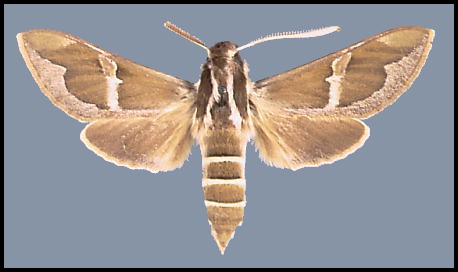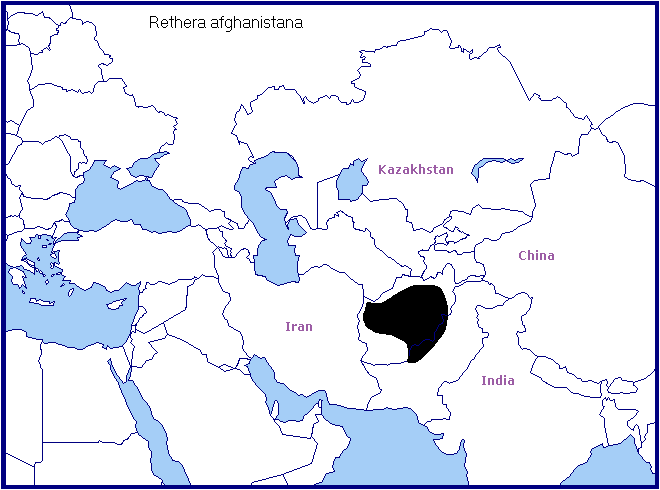Type species: Deilephila komarovi Christoph, 1885.
A western Palaearctic genus containing four species.
IMAGO: Wings entire. Eye with moderate lashes. Labial palpus obtuse, rounded in dorsal and lateral aspect. Antenna club-shaped, abruptly tapering to form a short hook. Terminal segment short, not long and filiform; seriate setae in male vestigial. Epiphysis of foretibia extending beyond apex. Mid- and hindtibial spurs unequal, long spur less than half as long as the respective first tarsal segment. First hindtarsal segment longer than first midtibial one, and about as long as hindtibia. Pulvillus and paronychium absent. Veins Rs and M1 of hindwing stalked.
Genitalia. Friction scales of male valva truncate, rather small. Valva elongate, sole-shaped; sacculus ending in an obtuse process with parallel sides and concave upper surface. Phallus with an oblique series of cornuti.
OVUM: Known only for Rethera komarovi (Christoph, 1885). Large, ovoid, glossy blue-green with a white encircling line which changes to brown after a few days.
LARVA: Known only for Rethera komarovi. Head small; tapering anteriorly, with the head and thoracic segments 1 and 2 retractile into thoracic segment 3 and abdominal segment 1. Horn absent in final instar; spiracles of abdominal segments 1 and 8 surrounded with eye-spots. Diffuse oblique lateral stripes present on abdominal segments.
PUPA: Known only for Rethera komarovi. Dark brown, very glossy. Proboscis fused with body; produced forward as in Hippotion but not laterally compressed. Cremaster large with a pair of apical spines.
HOSTPLANT FAMILIES: Principally herbaceous plants of the Rubiaceae.
UK: Afghan Madder Hawkmoth
Rethera afghanistana Daniel, 1958. Beitr. naturk. Forsch. SuedwDtl. 17: 83--84.Type locality: Herat, Afghanistan.
Holarctic; western Palaearctic region. Pleistocene refuge: Monocentric -- unclear, probably monocentric in the eastern half of the Iranian refuge, or Afghan subsection of the Turkestan refuge, or the Iranoeremic refuge.

Wingspan: 46--51mm. Similar to, but larger than Rethera brandti O. Bang-Haas, 1937.
Nothing known, except that it occurs at 1000--2100m.
Probably univoltine; mid-April (Herat) and late May (Kabul).
Unknown.
Unknown.
First discovered at Herat in western Afghanistan, this species is now known to occur throughout most of Afghanistan (Ebert, 1969; Daniel, 1971). Also recorded from 'Pakistan, 80km NW of Quetta, Kodschak-Pass [= Khonjuk Pass], 2100m, v. 1965' (Daniel, 1971). It may yet be discovered in central Iran.
Extra-limital range. None.

 Return to species list
Return to species list